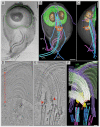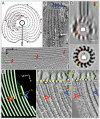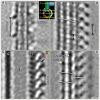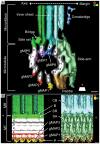A detailed, hierarchical study of Giardia lamblia's ventral disc reveals novel microtubule-associated protein complexes
- PMID: 22984443
- PMCID: PMC3439489
- DOI: 10.1371/journal.pone.0043783
A detailed, hierarchical study of Giardia lamblia's ventral disc reveals novel microtubule-associated protein complexes
Abstract
Giardia lamblia is a flagellated, unicellular parasite of mammals infecting over one billion people worldwide. Giardia's two-stage life cycle includes a motile trophozoite stage that colonizes the host small intestine and an infectious cyst form that can persist in the environment. Similar to many eukaryotic cells, Giardia contains several complex microtubule arrays that are involved in motility, chromosome segregation, organelle transport, maintenance of cell shape and transformation between the two life cycle stages. Giardia trophozoites also possess a unique spiral microtubule array, the ventral disc, made of approximately 50 parallel microtubules and associated microribbons, as well as a variety of associated proteins. The ventral disc maintains trophozoite attachment to the host intestinal epithelium. With the help of a combined SEM/microtome based slice and view method called 3View® (Gatan Inc., Pleasanton, CA), we present an entire trophozoite cell reconstruction and describe the arrangement of the major cytoskeletal elements. To aid in future analyses of disc-mediated attachment, we used electron-tomography of freeze-substituted, plastic-embedded trophozoites to explore the detailed architecture of ventral disc microtubules and their associated components. Lastly, we examined the disc microtubule array in three dimensions in unprecedented detail using cryo-electron tomography combined with internal sub-tomogram volume averaging of repetitive domains. We discovered details of protein complexes stabilizing microtubules by attachment to their inner and outer wall. A unique tri-laminar microribbon structure is attached vertically to the disc microtubules and is connected to neighboring microribbons via crossbridges. This work provides novel insight into the structure of the ventral disc microtubules, microribbons and associated proteins. Knowledge of the components comprising these structures and their three-dimensional organization is crucial toward understanding how attachment via the ventral disc occurs in vivo.
Conflict of interest statement
Figures







Similar articles
-
A detailed look at the cytoskeletal architecture of the Giardia lamblia ventral disc.J Struct Biol. 2016 Apr;194(1):38-48. doi: 10.1016/j.jsb.2016.01.011. Epub 2016 Jan 25. J Struct Biol. 2016. PMID: 26821343 Free PMC article.
-
Imaging and analysis of the microtubule cytoskeleton in giardia.Methods Cell Biol. 2010;97:307-39. doi: 10.1016/S0091-679X(10)97017-9. Methods Cell Biol. 2010. PMID: 20719278 Review.
-
An insider's guide to the microtubule cytoskeleton of Giardia.Cell Microbiol. 2010 May 1;12(5):588-98. doi: 10.1111/j.1462-5822.2010.01458.x. Epub 2010 Feb 24. Cell Microbiol. 2010. PMID: 20184590 Review.
-
Microtubule organelles in Giardia.Adv Parasitol. 2020;107:25-96. doi: 10.1016/bs.apar.2019.11.001. Epub 2020 Feb 5. Adv Parasitol. 2020. PMID: 32122531 Free PMC article. Review.
-
Nanoarchitecture of the ventral disc of Giardia intestinalis as revealed by high-resolution scanning electron microscopy and helium ion microscopy.Histochem Cell Biol. 2022 Feb;157(2):251-265. doi: 10.1007/s00418-021-02060-2. Epub 2022 Jan 20. Histochem Cell Biol. 2022. PMID: 35048193
Cited by
-
Cryo-EM structure of cortical microtubules from human parasite Toxoplasma gondii identifies their microtubule inner proteins.Nat Commun. 2021 May 24;12(1):3065. doi: 10.1038/s41467-021-23351-1. Nat Commun. 2021. PMID: 34031406 Free PMC article.
-
The Critical Role of the Cytoskeleton in the Pathogenesis of Giardia.Curr Clin Microbiol Rep. 2015 Dec;2(4):155-162. doi: 10.1007/s40588-015-0026-y. Epub 2015 Oct 8. Curr Clin Microbiol Rep. 2015. PMID: 27347476 Free PMC article.
-
Single particle tomography in EMAN2.J Struct Biol. 2015 Jun;190(3):279-90. doi: 10.1016/j.jsb.2015.04.016. Epub 2015 May 5. J Struct Biol. 2015. PMID: 25956334 Free PMC article.
-
Ultrastructural Alterations of the Human Pathogen Giardia intestinalis after Drug Treatment.Pathogens. 2023 Jun 7;12(6):810. doi: 10.3390/pathogens12060810. Pathogens. 2023. PMID: 37375500 Free PMC article. Review.
-
Identification of Actin Filament-Associated Proteins in Giardia lamblia.Microbiol Spectr. 2021 Sep 3;9(1):e0055821. doi: 10.1128/Spectrum.00558-21. Epub 2021 Jul 21. Microbiol Spectr. 2021. PMID: 34287056 Free PMC article.
References
-
- Savioli L, Smith H, Thompson A (2006) Giardia and Cryptosporidium join the “Neglected Diseases Initiative”. Trends in parasitology 22: 203–208. - PubMed
-
- Thompson RC (2000) Giardiasis as a re-emerging infectious disease and its zoonotic potential. International journal for parasitology 30: 1259–1267. - PubMed
-
- Land KM, Johnson PJ (1999) Molecular basis of metronidazole resistance in pathogenic bacteria and protozoa. Drug resistance updates: reviews and commentaries in antimicrobial and anticancer chemotherapy 2: 289–294. - PubMed

